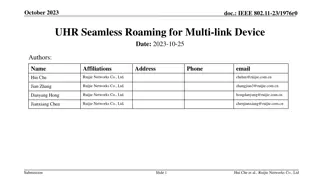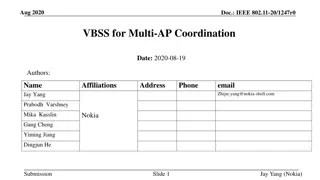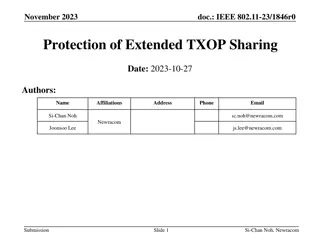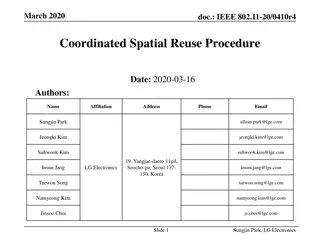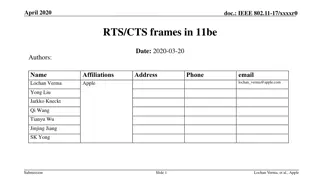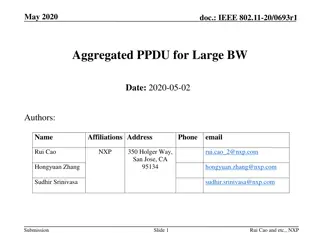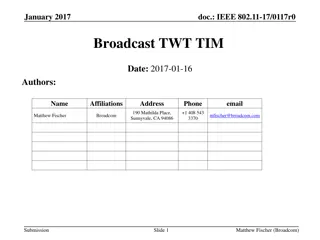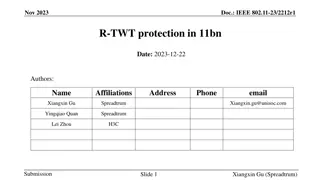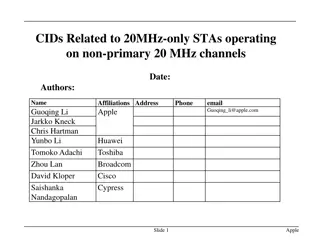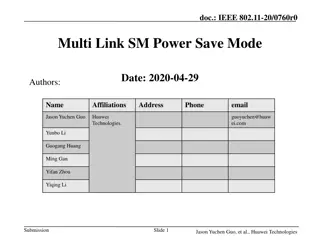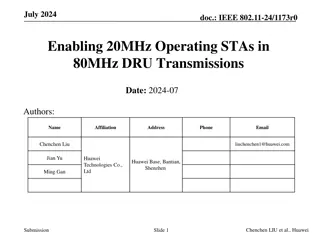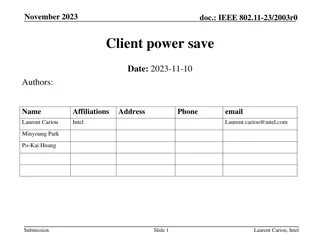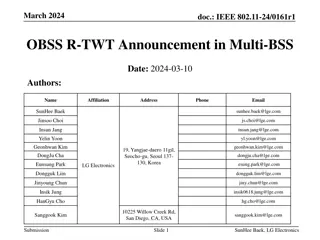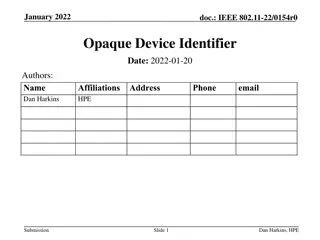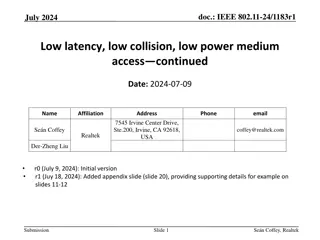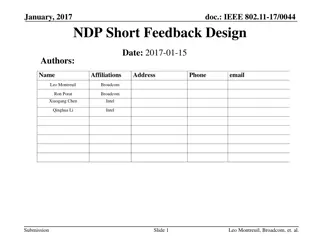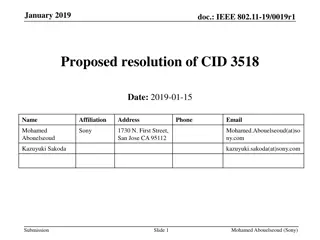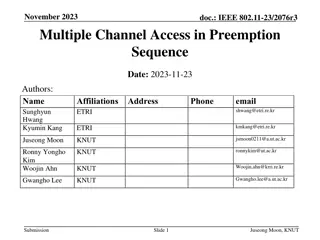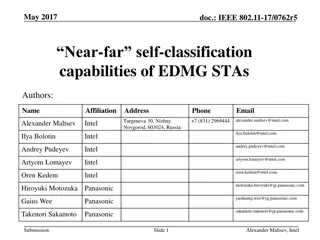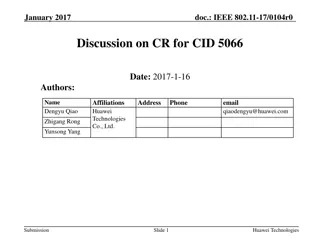How to Collect STAs Tx Demands for UL MU
This presentation addresses the methodology of gathering STAs' transmission demands for UL MU scenarios in IEEE 802.11-15/0855r1. It discusses the concept of STA-oriented notification for transmitting demands and explores additional information required for trigger frames to initiate UL MU transmissions effectively.
Download Presentation

Please find below an Image/Link to download the presentation.
The content on the website is provided AS IS for your information and personal use only. It may not be sold, licensed, or shared on other websites without obtaining consent from the author.If you encounter any issues during the download, it is possible that the publisher has removed the file from their server.
You are allowed to download the files provided on this website for personal or commercial use, subject to the condition that they are used lawfully. All files are the property of their respective owners.
The content on the website is provided AS IS for your information and personal use only. It may not be sold, licensed, or shared on other websites without obtaining consent from the author.
E N D
Presentation Transcript
July 2015 doc.: IEEE 802.11-15/0855r1 How to collect STAs Tx demands for UL MU Date: 2015-07-13 Authors: Name Tomoko Adachi Affiliations Address Toshiba Corporation Phone email tomo.adachi@toshiba.co.jp Submission Slide 1 Tomoko Adachi, Toshiba
July 2015 doc.: IEEE 802.11-15/0855r1 Abstract This presentation breaks down the issues of how to collect STAs Tx demands for UL-MU from the feedbacks given in the previous meeting. Submission Slide 2 Tomoko Adachi, Toshiba
July 2015 doc.: IEEE 802.11-15/0855r1 An approach to collect STAs Tx demands A need of a rough way to grasp or estimate STAs TX demands was suggested [1]. STA-oriented way of notification, where TX demand is shown in a field something like a More Data field, was proposed and its concept was shown to be acceptable by a straw poll [2] Straw Poll 5: For an AP to send the trigger frame for UL MU TX, do you think it is useful if a STA is able to notify the AP of its TX demand by a field something like a More Data field in a frame sent from its side? no objections Submission Slide 3 Tomoko Adachi, Toshiba
July 2015 doc.: IEEE 802.11-15/0855r1 Recalling STA-oriented way of Tx demand notification [2] STA 1 to AP STA 3 to AP Data BA/ACK Data BA/ACK same from STA 4 and 6 data data notification of remaining data in MAC header notification of remaining data in MAC header collected by AP AP recognizes STAs 1, 3, 4, and 6 have MSDUs to transmit* * may also need to consider group IDs for selecting STAs AP sends the trigger frame to STAs 1, 3, 4, and 6 Submission Slide 4 Tomoko Adachi, Toshiba
July 2015 doc.: IEEE 802.11-15/0855r1 More Data field may not be enough From the discussions related to the trigger initiating UL-MU Tx which took place in the May session, an AP may want the following info besides each STA s Tx demands: amount of buffered MSDUs/A-MSDUs in order to specify PPDU duration straw poll 3 in [2]: What kind of information should be specified in a trigger frame? PPDU duration (TBD, may be exact or maximum) no objections Submission Slide 5 Tomoko Adachi, Toshiba
July 2015 doc.: IEEE 802.11-15/0855r1 Consideration on QoS control field There were opinions to use QoS control field. QoS control field (IEEE Std 802.11-2012): Submission Slide 6 Tomoko Adachi, Toshiba
July 2015 doc.: IEEE 802.11-15/0855r1 Consideration on QoS control field AP PS Buffer State subfield to be precise, it is the QoS AP Buffered Load subfield The AP Buffered Load subfield is 4 bits in length and is used to indicate the total buffer size, rounded up to the nearest multiple of 4096 octets and expressed in units of 4096 octets, of all MSDUs and A-MSDUs buffered at the QoS AP (excluding the MSDU or A-MSDU of the present QoS data frame). TXOP Duration Requested subfield The Queue Size subfield is an 8-bit field that indicates the amount of buffered traffic for a given TC or TS at the STA sending this frame. Queue Size subfield The TXOP Duration Requested subfield is an 8-bit field that indicates the duration, in units of 32 s, that the sending STA determines it needs for its next TXOP for the specified TID. AP PS Buffer State subfield has the best fit to what we want Submission Slide 7 Tomoko Adachi, Toshiba
July 2015 doc.: IEEE 802.11-15/0855r1 Discussion points on AP PS buffer State subfield From the current baseline, this can be used only at APs. We want such info from non-AP STAs but there are other definitions already for non-AP STAs Withdraw the current definition for non-AP STAs and re-specify for HEW STAs? Thinking about the relation between mesh STAs, this seems to be difficult. Extend HT Control field to further include HE variant? Use B1 of VHT variant which is currently reserved for distinction? Can we throw over the current VHT params? Create a new HEW control field? Other solution? Slide 8 Submission Tomoko Adachi, Toshiba
July 2015 doc.: IEEE 802.11-15/0855r1 Discussion points on AP PS buffer State subfield Although if we can re-use the current subfield The AP Buffered Load subfield inside expresses the total buffer size in units of 4096 octets. OFDMA shows higher performance for short packets, say up to 1k octets. Won t units of 4096 octets be too rough to express the demands of short packets? more small units preferred? The AP Buffered Load subfield value of 15 indicates that the buffer size is greater than 57 344 octets. On the other hand, thinking of the aggregation size increased by 11ac and the possibility of being increased more, especially for MU-MIMO (and more higher MCSs added?), upper limit may need to be more larger. more than the current 4 bits preferred? or enlarge unit size? Submission Slide 9 Tomoko Adachi, Toshiba
July 2015 doc.: IEEE 802.11-15/0855r1 One idea to make the unit size of the AP Buffered Load subfield flexible set a field that expresses the unit size in use ex. B8-9 as Unit Size subfield (2 bits) 00 definition total buffer size is expressed in units of 256 octets total buffer size is expressed in units of 4096 octets total buffer size is expressed in units of 8192 octets reserved 01 10 11 Submission
July 2015 doc.: IEEE 802.11-15/0855r1 Other candidate info to collect triggered cycle request? STAs having short lifetime data may want to request triggered cycle. However, TSPEC element has the following parameters : Minimum Service Interval, Maximum Service Interval, Minimum Data Rate, Mean Data Rate, Peak Data Rate these info collected from the non-AP STAs prior to data exchange may be reflected to schedule the trigger frame. Submission Slide 11 Tomoko Adachi, Toshiba
July 2015 doc.: IEEE 802.11-15/0855r1 My two cents on the trigger frame Reviewing the baseline, we already use the term trigger frame so we need to reconsider the frame name. Will the trigger frame need to be a unified format for both UL-MU-MIMO and UL-OFDMA? Do we allow their combination? A frame to trigger UL-MU-MIMO needs to allocate spatial streams to STAs. A frame to trigger UL-OFDMA needs to allocate resource units to STAs. Submission Slide 12 Tomoko Adachi, Toshiba
July 2015 doc.: IEEE 802.11-15/0855r1 Summary For the trigger frame to specify the PPDU duration of UL-MU, AP may want amount of buffered data at STAs and 1 bit More Data field is not enough. Reviewing QoS Control field, AP PS Buffer State subfield has the best fit, but in the current definition, that can t be used for non-AP STAs. Also the current unit size and its upper limit was questioned. Submission Slide 13 Tomoko Adachi, Toshiba
July 2015 doc.: IEEE 802.11-15/0855r1 References [1] 802.11-15/0064r1 Consideration on UL-MU overheads [2] 802.11-15/0608r1 Regarding trigger frame in UL MU Submission Slide 14 Tomoko Adachi, Toshiba
July 2015 doc.: IEEE 802.11-15/0855r1 Straw poll 1 Do you think we should withdraw the current definition of Bits 8-15 in QoS Control field for non-AP STAs and re-specify for HEW STAs to indicate buffer load? Y:N:A= Submission Slide 15 Tomoko Adachi, Toshiba
July 2015 doc.: IEEE 802.11-15/0855r1 Straw poll 2 Do you think we should extend HT Control field to further include HE variant and indicate buffer load there? Y:N:A= Submission Slide 16 Tomoko Adachi, Toshiba
July 2015 doc.: IEEE 802.11-15/0855r1 Straw poll 3 Do you think we should create a new HEW control field to indicate buffer load there? Y:N:A= Submission Slide 17 Tomoko Adachi, Toshiba
July 2015 doc.: IEEE 802.11-15/0855r1 SP Which option do you prefer for indicating the buffer load? 1. Modifying the current definition of the QoS Control field (bits 8-15) - 15 2. HEW-Variant of the HT Control field -1 3. New HEW Control field -3 4. Abstain - 49 Submission Slide 18 Tomoko Adachi, Toshiba









